Case Study Analysis: Betty Hill's Colorectal Cancer Journey, HSNS364
VerifiedAdded on 2022/08/18
|6
|1309
|9
Case Study
AI Summary
This case study examines the case of Betty Hill, a 62-year-old woman diagnosed with colorectal cancer, exploring her journey from initial symptoms to diagnosis, treatment, and survivorship. The study delves into the assessment tools used to evaluate the effects of her chemotherapy, particularly nausea and vomiting, including the MASCC Antiemesis Tool. It highlights the roles of various healthcare professionals involved in her care, including her medical team, husband, and community support group, emphasizing the importance of a holistic approach. Furthermore, the case study discusses health promotion and prevention strategies implemented by the Australian government to address cancer, such as collaboration, early detection methods, and immunotherapy. The analysis underscores the significance of family, community, and governmental initiatives in supporting cancer patients and survivors.
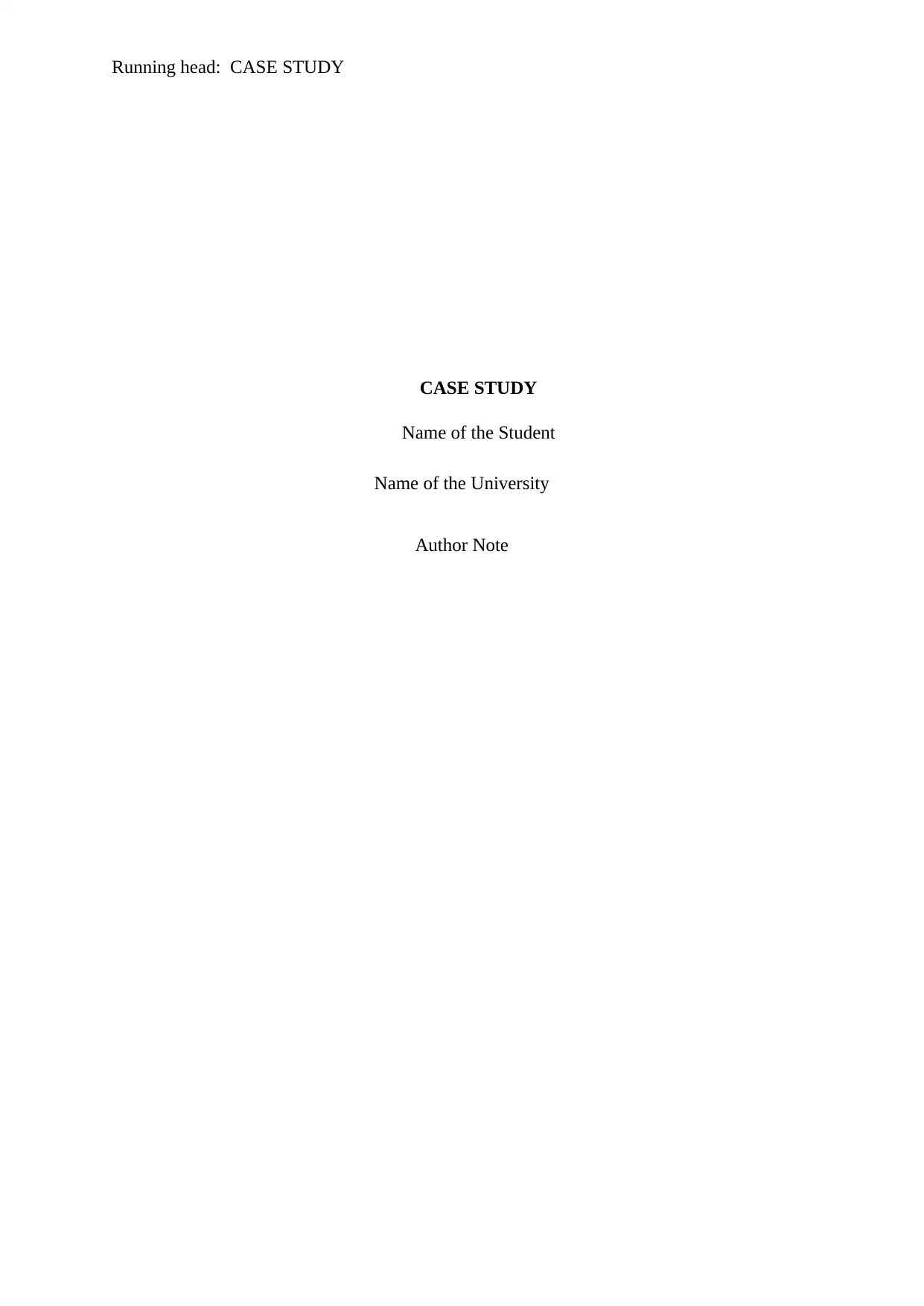
Running head: CASE STUDY
CASE STUDY
Name of the Student
Name of the University
Author Note
CASE STUDY
Name of the Student
Name of the University
Author Note
Paraphrase This Document
Need a fresh take? Get an instant paraphrase of this document with our AI Paraphraser
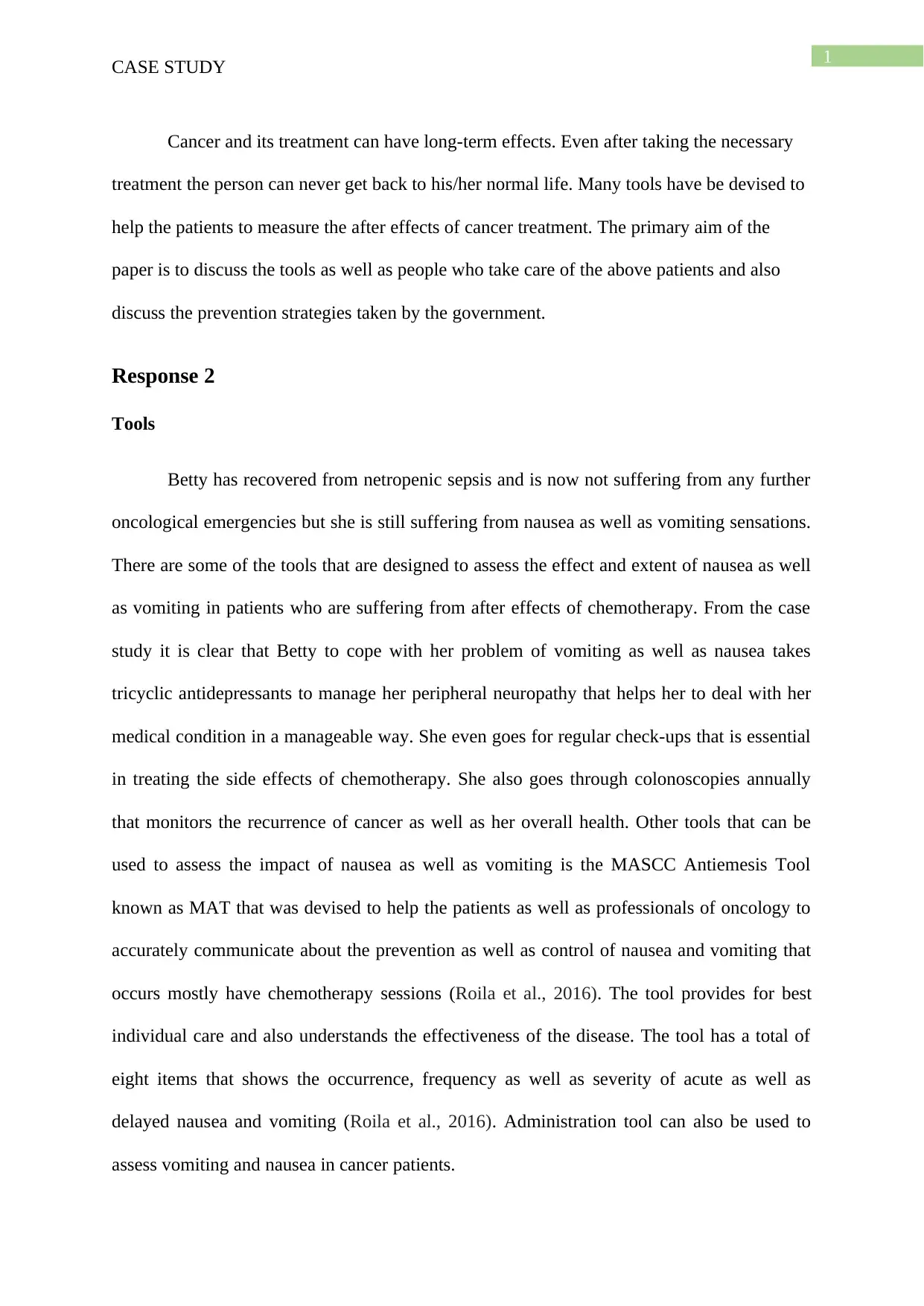
1
CASE STUDY
Cancer and its treatment can have long-term effects. Even after taking the necessary
treatment the person can never get back to his/her normal life. Many tools have be devised to
help the patients to measure the after effects of cancer treatment. The primary aim of the
paper is to discuss the tools as well as people who take care of the above patients and also
discuss the prevention strategies taken by the government.
Response 2
Tools
Betty has recovered from netropenic sepsis and is now not suffering from any further
oncological emergencies but she is still suffering from nausea as well as vomiting sensations.
There are some of the tools that are designed to assess the effect and extent of nausea as well
as vomiting in patients who are suffering from after effects of chemotherapy. From the case
study it is clear that Betty to cope with her problem of vomiting as well as nausea takes
tricyclic antidepressants to manage her peripheral neuropathy that helps her to deal with her
medical condition in a manageable way. She even goes for regular check-ups that is essential
in treating the side effects of chemotherapy. She also goes through colonoscopies annually
that monitors the recurrence of cancer as well as her overall health. Other tools that can be
used to assess the impact of nausea as well as vomiting is the MASCC Antiemesis Tool
known as MAT that was devised to help the patients as well as professionals of oncology to
accurately communicate about the prevention as well as control of nausea and vomiting that
occurs mostly have chemotherapy sessions (Roila et al., 2016). The tool provides for best
individual care and also understands the effectiveness of the disease. The tool has a total of
eight items that shows the occurrence, frequency as well as severity of acute as well as
delayed nausea and vomiting (Roila et al., 2016). Administration tool can also be used to
assess vomiting and nausea in cancer patients.
CASE STUDY
Cancer and its treatment can have long-term effects. Even after taking the necessary
treatment the person can never get back to his/her normal life. Many tools have be devised to
help the patients to measure the after effects of cancer treatment. The primary aim of the
paper is to discuss the tools as well as people who take care of the above patients and also
discuss the prevention strategies taken by the government.
Response 2
Tools
Betty has recovered from netropenic sepsis and is now not suffering from any further
oncological emergencies but she is still suffering from nausea as well as vomiting sensations.
There are some of the tools that are designed to assess the effect and extent of nausea as well
as vomiting in patients who are suffering from after effects of chemotherapy. From the case
study it is clear that Betty to cope with her problem of vomiting as well as nausea takes
tricyclic antidepressants to manage her peripheral neuropathy that helps her to deal with her
medical condition in a manageable way. She even goes for regular check-ups that is essential
in treating the side effects of chemotherapy. She also goes through colonoscopies annually
that monitors the recurrence of cancer as well as her overall health. Other tools that can be
used to assess the impact of nausea as well as vomiting is the MASCC Antiemesis Tool
known as MAT that was devised to help the patients as well as professionals of oncology to
accurately communicate about the prevention as well as control of nausea and vomiting that
occurs mostly have chemotherapy sessions (Roila et al., 2016). The tool provides for best
individual care and also understands the effectiveness of the disease. The tool has a total of
eight items that shows the occurrence, frequency as well as severity of acute as well as
delayed nausea and vomiting (Roila et al., 2016). Administration tool can also be used to
assess vomiting and nausea in cancer patients.
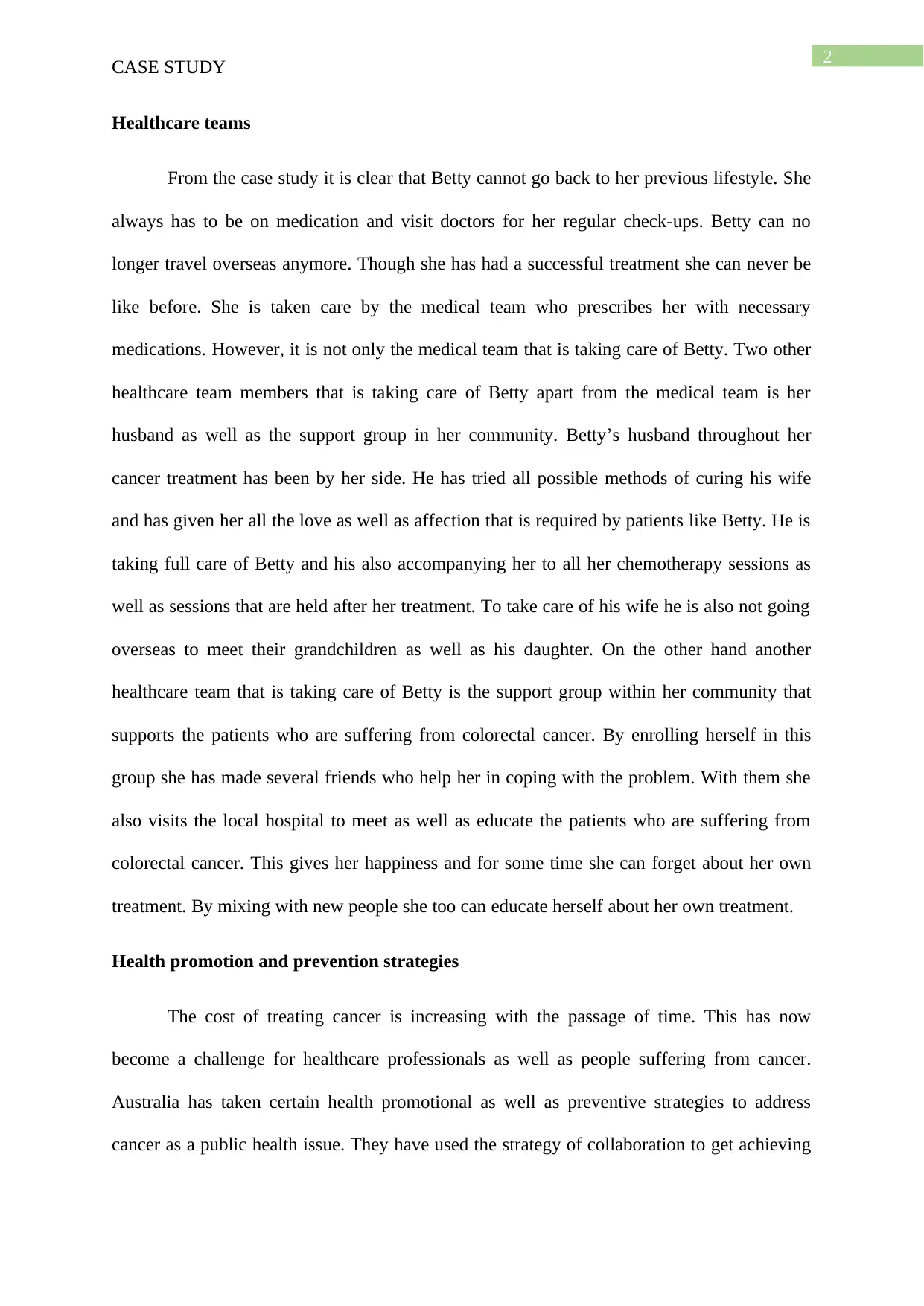
2
CASE STUDY
Healthcare teams
From the case study it is clear that Betty cannot go back to her previous lifestyle. She
always has to be on medication and visit doctors for her regular check-ups. Betty can no
longer travel overseas anymore. Though she has had a successful treatment she can never be
like before. She is taken care by the medical team who prescribes her with necessary
medications. However, it is not only the medical team that is taking care of Betty. Two other
healthcare team members that is taking care of Betty apart from the medical team is her
husband as well as the support group in her community. Betty’s husband throughout her
cancer treatment has been by her side. He has tried all possible methods of curing his wife
and has given her all the love as well as affection that is required by patients like Betty. He is
taking full care of Betty and his also accompanying her to all her chemotherapy sessions as
well as sessions that are held after her treatment. To take care of his wife he is also not going
overseas to meet their grandchildren as well as his daughter. On the other hand another
healthcare team that is taking care of Betty is the support group within her community that
supports the patients who are suffering from colorectal cancer. By enrolling herself in this
group she has made several friends who help her in coping with the problem. With them she
also visits the local hospital to meet as well as educate the patients who are suffering from
colorectal cancer. This gives her happiness and for some time she can forget about her own
treatment. By mixing with new people she too can educate herself about her own treatment.
Health promotion and prevention strategies
The cost of treating cancer is increasing with the passage of time. This has now
become a challenge for healthcare professionals as well as people suffering from cancer.
Australia has taken certain health promotional as well as preventive strategies to address
cancer as a public health issue. They have used the strategy of collaboration to get achieving
CASE STUDY
Healthcare teams
From the case study it is clear that Betty cannot go back to her previous lifestyle. She
always has to be on medication and visit doctors for her regular check-ups. Betty can no
longer travel overseas anymore. Though she has had a successful treatment she can never be
like before. She is taken care by the medical team who prescribes her with necessary
medications. However, it is not only the medical team that is taking care of Betty. Two other
healthcare team members that is taking care of Betty apart from the medical team is her
husband as well as the support group in her community. Betty’s husband throughout her
cancer treatment has been by her side. He has tried all possible methods of curing his wife
and has given her all the love as well as affection that is required by patients like Betty. He is
taking full care of Betty and his also accompanying her to all her chemotherapy sessions as
well as sessions that are held after her treatment. To take care of his wife he is also not going
overseas to meet their grandchildren as well as his daughter. On the other hand another
healthcare team that is taking care of Betty is the support group within her community that
supports the patients who are suffering from colorectal cancer. By enrolling herself in this
group she has made several friends who help her in coping with the problem. With them she
also visits the local hospital to meet as well as educate the patients who are suffering from
colorectal cancer. This gives her happiness and for some time she can forget about her own
treatment. By mixing with new people she too can educate herself about her own treatment.
Health promotion and prevention strategies
The cost of treating cancer is increasing with the passage of time. This has now
become a challenge for healthcare professionals as well as people suffering from cancer.
Australia has taken certain health promotional as well as preventive strategies to address
cancer as a public health issue. They have used the strategy of collaboration to get achieving
⊘ This is a preview!⊘
Do you want full access?
Subscribe today to unlock all pages.

Trusted by 1+ million students worldwide
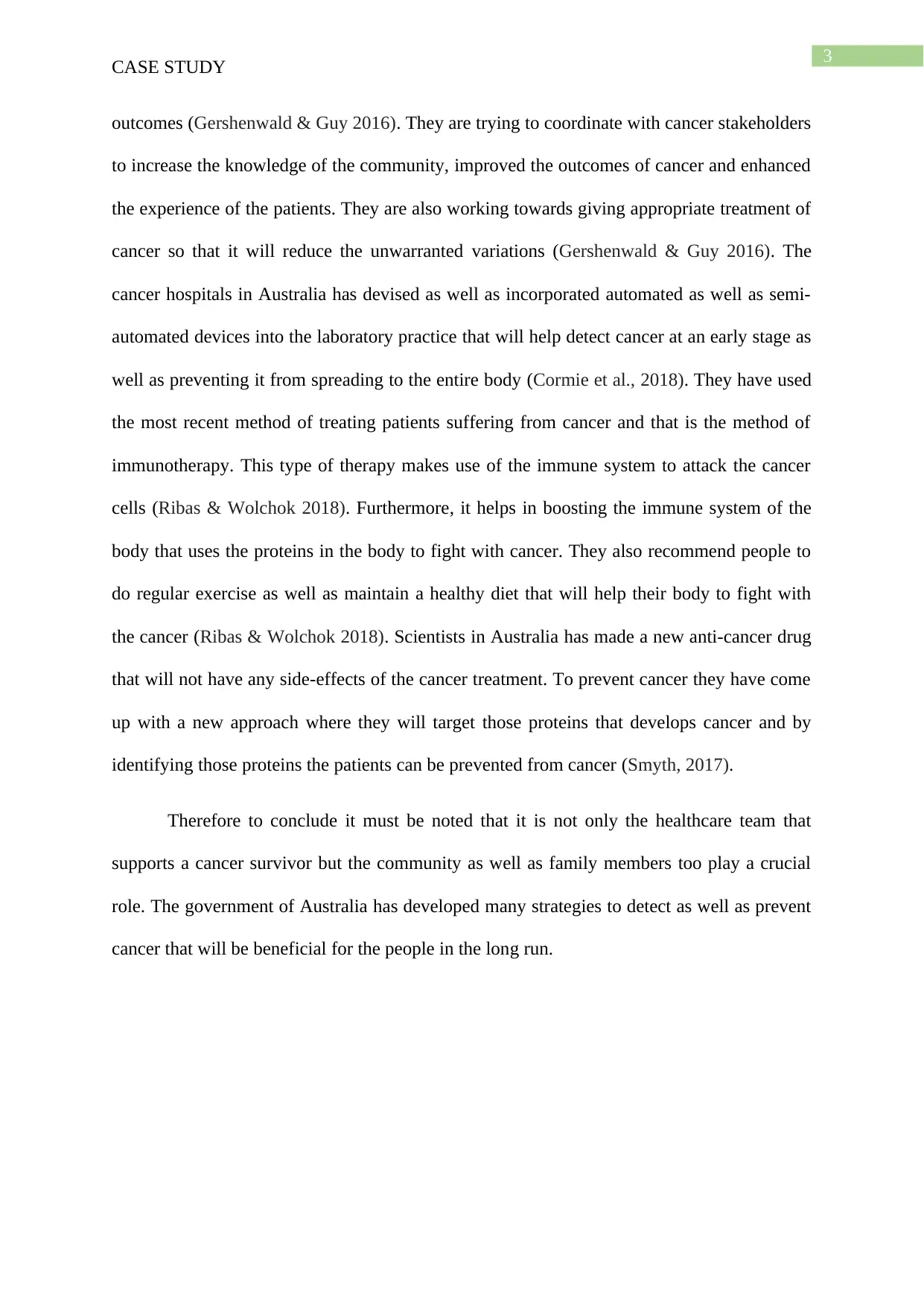
3
CASE STUDY
outcomes (Gershenwald & Guy 2016). They are trying to coordinate with cancer stakeholders
to increase the knowledge of the community, improved the outcomes of cancer and enhanced
the experience of the patients. They are also working towards giving appropriate treatment of
cancer so that it will reduce the unwarranted variations (Gershenwald & Guy 2016). The
cancer hospitals in Australia has devised as well as incorporated automated as well as semi-
automated devices into the laboratory practice that will help detect cancer at an early stage as
well as preventing it from spreading to the entire body (Cormie et al., 2018). They have used
the most recent method of treating patients suffering from cancer and that is the method of
immunotherapy. This type of therapy makes use of the immune system to attack the cancer
cells (Ribas & Wolchok 2018). Furthermore, it helps in boosting the immune system of the
body that uses the proteins in the body to fight with cancer. They also recommend people to
do regular exercise as well as maintain a healthy diet that will help their body to fight with
the cancer (Ribas & Wolchok 2018). Scientists in Australia has made a new anti-cancer drug
that will not have any side-effects of the cancer treatment. To prevent cancer they have come
up with a new approach where they will target those proteins that develops cancer and by
identifying those proteins the patients can be prevented from cancer (Smyth, 2017).
Therefore to conclude it must be noted that it is not only the healthcare team that
supports a cancer survivor but the community as well as family members too play a crucial
role. The government of Australia has developed many strategies to detect as well as prevent
cancer that will be beneficial for the people in the long run.
CASE STUDY
outcomes (Gershenwald & Guy 2016). They are trying to coordinate with cancer stakeholders
to increase the knowledge of the community, improved the outcomes of cancer and enhanced
the experience of the patients. They are also working towards giving appropriate treatment of
cancer so that it will reduce the unwarranted variations (Gershenwald & Guy 2016). The
cancer hospitals in Australia has devised as well as incorporated automated as well as semi-
automated devices into the laboratory practice that will help detect cancer at an early stage as
well as preventing it from spreading to the entire body (Cormie et al., 2018). They have used
the most recent method of treating patients suffering from cancer and that is the method of
immunotherapy. This type of therapy makes use of the immune system to attack the cancer
cells (Ribas & Wolchok 2018). Furthermore, it helps in boosting the immune system of the
body that uses the proteins in the body to fight with cancer. They also recommend people to
do regular exercise as well as maintain a healthy diet that will help their body to fight with
the cancer (Ribas & Wolchok 2018). Scientists in Australia has made a new anti-cancer drug
that will not have any side-effects of the cancer treatment. To prevent cancer they have come
up with a new approach where they will target those proteins that develops cancer and by
identifying those proteins the patients can be prevented from cancer (Smyth, 2017).
Therefore to conclude it must be noted that it is not only the healthcare team that
supports a cancer survivor but the community as well as family members too play a crucial
role. The government of Australia has developed many strategies to detect as well as prevent
cancer that will be beneficial for the people in the long run.
Paraphrase This Document
Need a fresh take? Get an instant paraphrase of this document with our AI Paraphraser
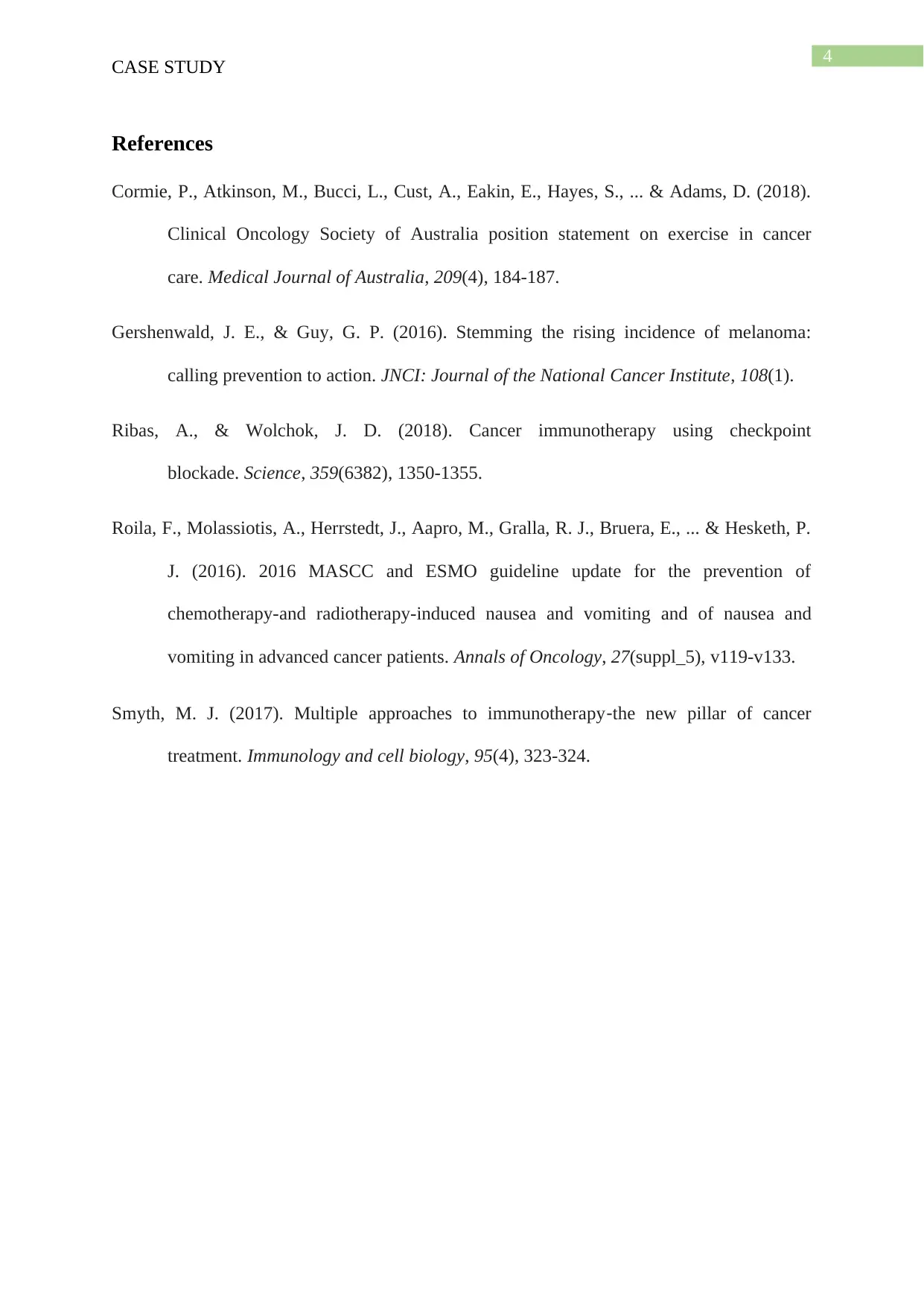
4
CASE STUDY
References
Cormie, P., Atkinson, M., Bucci, L., Cust, A., Eakin, E., Hayes, S., ... & Adams, D. (2018).
Clinical Oncology Society of Australia position statement on exercise in cancer
care. Medical Journal of Australia, 209(4), 184-187.
Gershenwald, J. E., & Guy, G. P. (2016). Stemming the rising incidence of melanoma:
calling prevention to action. JNCI: Journal of the National Cancer Institute, 108(1).
Ribas, A., & Wolchok, J. D. (2018). Cancer immunotherapy using checkpoint
blockade. Science, 359(6382), 1350-1355.
Roila, F., Molassiotis, A., Herrstedt, J., Aapro, M., Gralla, R. J., Bruera, E., ... & Hesketh, P.
J. (2016). 2016 MASCC and ESMO guideline update for the prevention of
chemotherapy-and radiotherapy-induced nausea and vomiting and of nausea and
vomiting in advanced cancer patients. Annals of Oncology, 27(suppl_5), v119-v133.
Smyth, M. J. (2017). Multiple approaches to immunotherapy‐the new pillar of cancer
treatment. Immunology and cell biology, 95(4), 323-324.
CASE STUDY
References
Cormie, P., Atkinson, M., Bucci, L., Cust, A., Eakin, E., Hayes, S., ... & Adams, D. (2018).
Clinical Oncology Society of Australia position statement on exercise in cancer
care. Medical Journal of Australia, 209(4), 184-187.
Gershenwald, J. E., & Guy, G. P. (2016). Stemming the rising incidence of melanoma:
calling prevention to action. JNCI: Journal of the National Cancer Institute, 108(1).
Ribas, A., & Wolchok, J. D. (2018). Cancer immunotherapy using checkpoint
blockade. Science, 359(6382), 1350-1355.
Roila, F., Molassiotis, A., Herrstedt, J., Aapro, M., Gralla, R. J., Bruera, E., ... & Hesketh, P.
J. (2016). 2016 MASCC and ESMO guideline update for the prevention of
chemotherapy-and radiotherapy-induced nausea and vomiting and of nausea and
vomiting in advanced cancer patients. Annals of Oncology, 27(suppl_5), v119-v133.
Smyth, M. J. (2017). Multiple approaches to immunotherapy‐the new pillar of cancer
treatment. Immunology and cell biology, 95(4), 323-324.

5
CASE STUDY
CASE STUDY
⊘ This is a preview!⊘
Do you want full access?
Subscribe today to unlock all pages.

Trusted by 1+ million students worldwide
1 out of 6
Related Documents
Your All-in-One AI-Powered Toolkit for Academic Success.
+13062052269
info@desklib.com
Available 24*7 on WhatsApp / Email
![[object Object]](/_next/static/media/star-bottom.7253800d.svg)
Unlock your academic potential
Copyright © 2020–2025 A2Z Services. All Rights Reserved. Developed and managed by ZUCOL.





